Physical Address
304 North Cardinal St.
Dorchester Center, MA 02124
Physical Address
304 North Cardinal St.
Dorchester Center, MA 02124

Otherworldly marine encounters await in these ten frosty dive spots, where penguins, shipwrecks, and pristine waters create unforgettable underwater adventures.
You might think warm-water diving destinations hold all the underwater treasures, but cold-water locations actually offer some of the most spectacular marine encounters on Earth. From swimming alongside penguins in Antarctica to exploring historic shipwrecks in Scotland’s Scapa Flow, these chilly waters pack serious adventure potential. While you’ll need specialized gear and training, the payoff includes crystal-clear visibility, unique marine life, and fewer crowds. Let’s explore ten destinations that’ll change your perspective on cold-water diving.
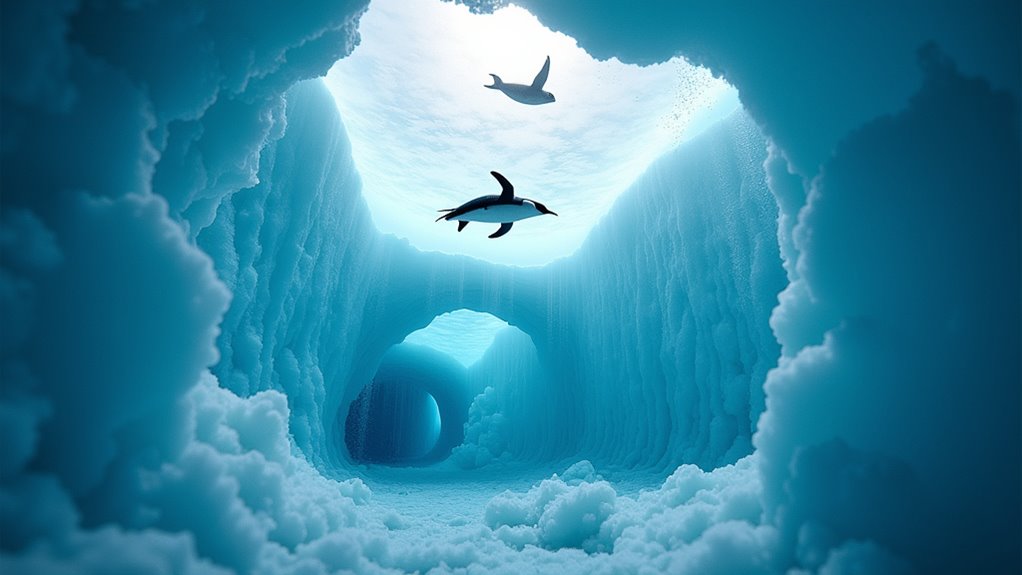
While many divers dream of tropical waters, Antarctica offers an unparalleled cold-water diving experience that’s worth the extra preparation and investment.
You’ll encounter crystal-clear visibility up to 985 feet and unique marine life, including penguins and seals, in their natural habitat. The opportunity to explore massive icebergs underwater is simply incomparable. Using rope harness systems is mandatory to prevent drifting away from access points during dives.
Before booking your trip, make sure you meet the strict requirements. You’ll need at least 30 dry suit dives, medical clearance, and proper certification.
Antarctica diving isn’t for novices. Extensive dry suit experience, medical approval, and advanced certifications are mandatory prerequisites for this extreme adventure.
Don’t skimp on equipment – you’ll require a dry suit, freeze-protected regulators, and specialized gear suited for temperatures between 28-36°F.
While the remote location and extreme conditions present challenges, proper preparation and experience will help you safely navigate this extraordinary underwater environment.
As Earth’s tectonic plates slowly drift apart, they’ve created one of diving’s most extraordinary sites – Iceland’s Silfra Fissure.
You’ll find yourself diving between the North American and Eurasian continents in water so clear you can see over 100 meters ahead.
The fissure’s glacial meltwater stays a chilly 2-4°C year-round, but don’t let that deter you.
You can explore depths up to 18 meters while witnessing vivid underwater colors and unique geological formations. The site has been a popular diving destination since Tómas Knútsson helped establish it in the 1990s.
What’s particularly appealing is that you don’t need advanced certification – the site welcomes both beginners and experienced divers.
Whether you’re diving or snorkeling, you’ll experience one of PADI’s top-rated sites worldwide.
Just remember to book ahead, as this bucket-list destination draws visitors enthusiastic to touch two continents simultaneously underwater.
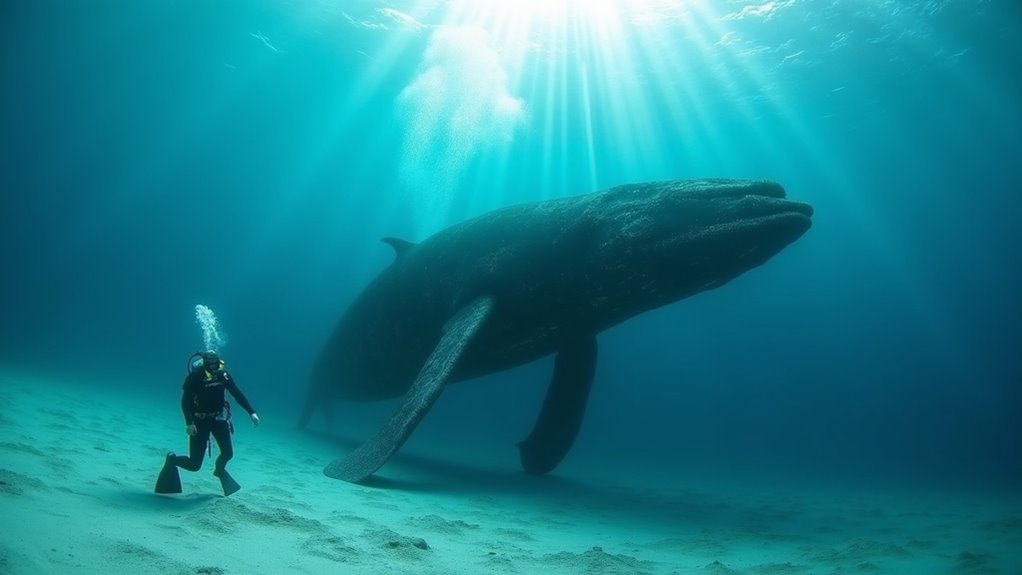
From Iceland’s crystal waters, let’s head south to Argentina’s Península Valdés, where cold-water diving takes on a completely different dimension.
This UNESCO World Heritage Site offers you the rare opportunity to dive with southern right whales in the pristine waters of Golfo Nuevo and Golfo San José. Strict regulations established since whale watching began in the mid-1970s ensure responsible tourism practices.
You’ll need to time your visit carefully, as whale migration patterns follow seasonal changes. The best encounters happen through guided tours, which guarantee both your safety and the protection of these marine giants.
While the cold waters and strong currents can be challenging, you’ll be rewarded with sightings of not just whales, but also sea lions, dolphins, and penguins.
Local operators follow strict regulations to maintain sustainable practices, and you’ll find reasonably priced packages that include necessary gear and expertise.
Nestled in Scotland’s Orkney Islands, Scapa Flow serves as one of the world’s most fascinating cold-water dive destinations, where history and marine life converge in crystal-clear waters.
You’ll discover seven remaining wrecks of the German High Seas Fleet, scuttled in 1919, making it a must-visit site for history enthusiasts.
While water temperatures range from 4°C to 14°C, you’ll need a drysuit and often Nitrox for comfortable exploration. The best time to visit is between mid-spring and mid-autumn when local dive operators are most active.
You’ll find several reputable companies offering guided tours of these historic wrecks. The varying depths of dive sites make Scapa Flow perfect for divers of all experience levels.
Despite the cold waters, you’ll encounter diverse marine life around vibrant reef ecosystems.
Remember to check weather forecasts and tide tables, as conditions can change rapidly in this sheltered but dynamic environment.
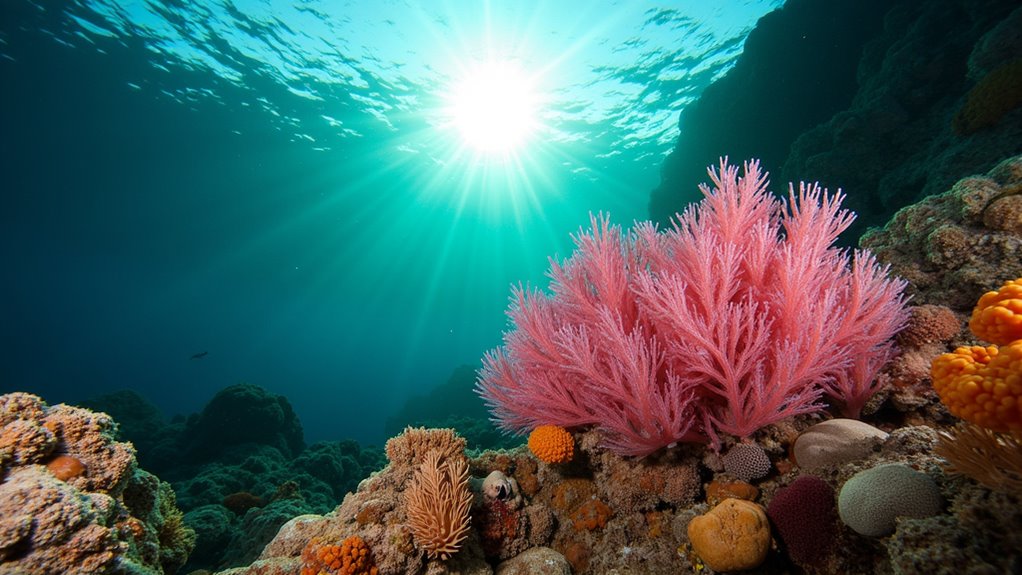
While tropical reefs often steal the spotlight, British Columbia’s cold waters harbor some of North America’s most spectacular diving.
You’ll find diverse diving environments, from the artificial reefs of Nanaimo to the current-swept walls of Port Hardy’s Browning Wall and God’s Pocket.
Winter offers the best visibility, reaching up to 100 feet, though you’ll need a drysuit for the chilly 7-13°C waters. Divers must wear thick exposure suits and protective gear to safely explore these cold-water environments.
The nutrient-rich currents support vibrant marine life, including wolf eels, Pacific octopuses, and colorful anemones. You can spot seals and sea lions at many sites, particularly around Nanaimo and Port Hardy.
For budget-conscious divers, timing is essential.
Plan your dives during slack tide to avoid dangerous currents, and consider joining group charters to share boat costs to remote locations.
Moving south from British Columbia’s cold waters, South Australia’s marine parks offer an equally compelling underwater experience.
You’ll discover 19 marine parks covering 44% of state waters, with sanctuary zones protecting the region’s most pristine areas. The region sustains an incredible 33 marine mammal species throughout its diverse ecosystems. As a global hotspot for temperate marine life, these waters boast exceptional biodiversity and endemic species you won’t find anywhere else.
Most parks allow public access with varying protection levels, making them accessible for divers while ensuring habitat preservation.
Time your visit during the austral summer for ideal diving conditions.
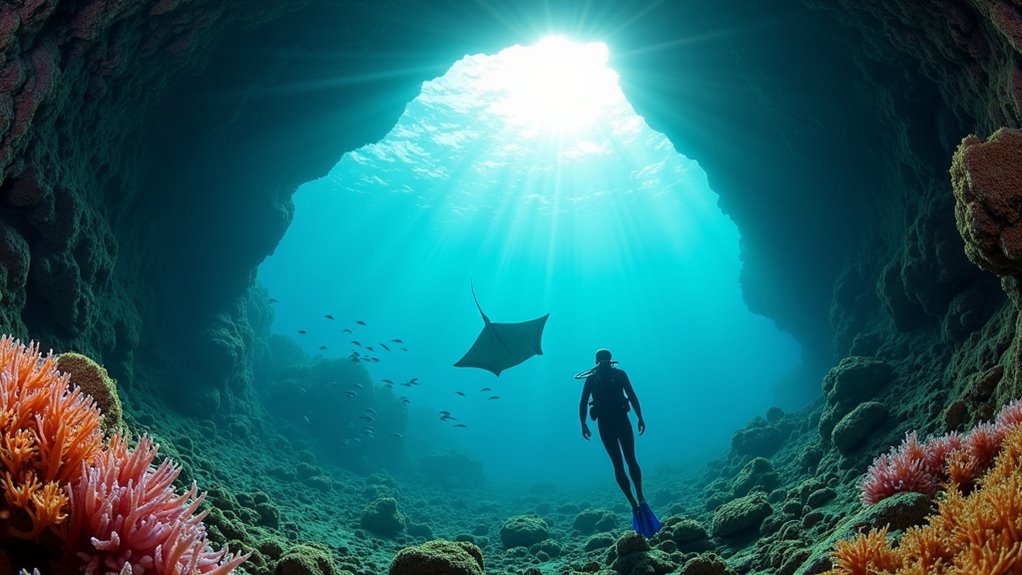
Located off New Zealand’s Tutukākā coast, the Poor Knights Islands stand as one of the world’s premier cold-water diving destinations.
You’ll find these volcanic islands just 22 km offshore, where dramatic underwater cliffs plunge over 100 meters into crystal-clear waters.
The islands’ unique position catches subtropical currents from the Coral Sea, creating an environment where you’ll encounter diverse marine life, from large schools of trevally to curious rays. For an extraordinary experience, visit Rikoriko Cave, the largest sea cave by volume in the entire southern hemisphere.
Winter brings the best visibility, often exceeding 20 meters, though you’ll need to prepare for water temperatures between 14-21°C.
Access is exclusively by boat from Tutukaka, and strict conservation measures protect the marine reserve’s biodiversity.
You can explore underwater caves, arches, and unique geological formations while diving in this pristine environment, making it well worth the journey to New Zealand’s northern waters.
A mesmerizing world of towering kelp forests awaits divers at California’s Channel Islands, where five main islands offer year-round diving opportunities just off the Southern California coast. Early fall brings peak visibility conditions of 60-90 feet underwater, making it the best time to explore these waters.
You’ll discover an underwater paradise where kelp grows up to 150 feet tall, providing shelter for over 1,000 marine species. Dive boats like the Spectre depart regularly from Ventura County, making these sites accessible for both day trips and extended adventures.
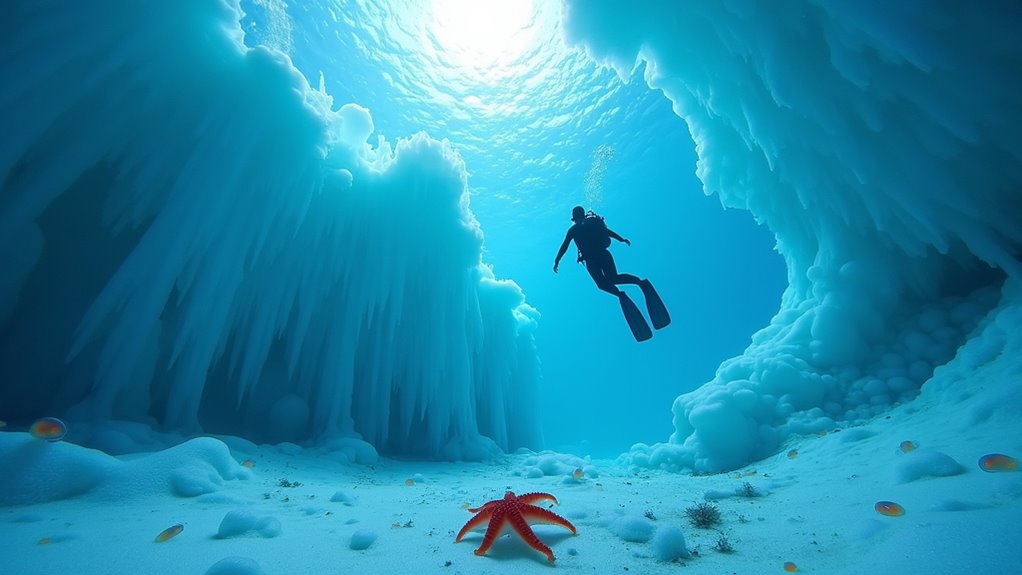
From the warm kelp forests of California, we venture to Russia’s stunning White Sea, where ice diving adventures reach their peak between February and April.
You’ll discover crystal-clear waters with visibility up to 30 meters beneath ice that’s typically 40-50 cm thick.
Don’t let the -10°C air temperature deter you – the underwater world here is worth braving the cold. You’ll need specialized training and gear, but local operators provide experienced instructors and extensive safety protocols.
The frigid temperatures test your resolve, but with proper training and expert guidance, the White Sea’s underwater treasures await your discovery.
Popular sites like Big Cross Island showcase a mesmerizing array of cold-water marine life, including anemones, starfish, and ethereal sea angels. Lucky divers might witness nature’s most spectacular light show as the Northern Lights dance above the frozen surface during night dives.
Between dives, you can explore nearby Russian villages and learn about local culture, making your White Sea expedition both an underwater adventure and a cultural journey.
While Cape Town’s pristine beaches draw travelers to its shores, the real treasures lie beneath the waves of the Cape Peninsula.
You’ll discover diverse dive sites, from the kelp forests teeming with marine life to the historic Smitswinkel Bay wrecks. Simon’s Town offers notably rich kelp forests that create intricate underwater habitats for countless species. Into the Blue Dive Center at Sea Point offers convenient access and essential cold-water gear rentals.
The peninsula’s unique marine ecosystem rewards divers with encounters you won’t find in tropical waters.
You’ll find that cold-water diving isn’t just about braving lower temperatures – it’s about accessing some of Earth’s most pristine and uncrowded dive sites. While these destinations require more gear investment upfront, they’ll reward you with clearer visibility and unique marine encounters you won’t find in tropical waters. Start with local cold-water dives to test your comfort level before planning these bucket-list adventures.